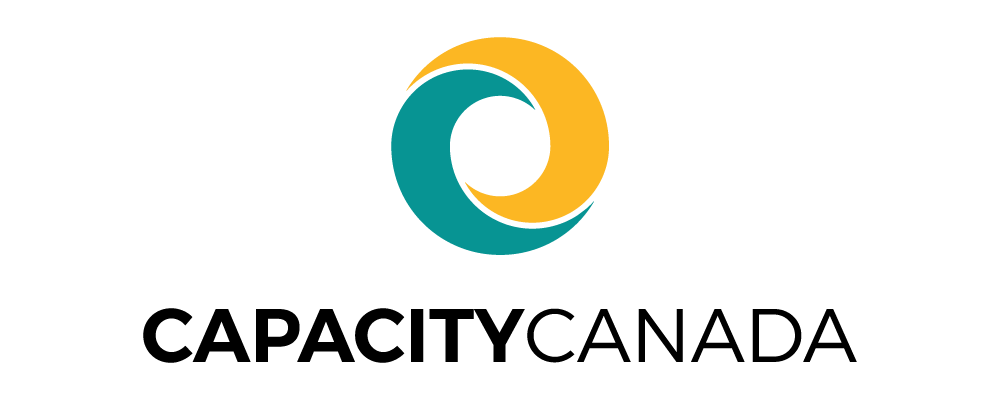|
Getting your Trinity Audio player ready...
|
Capacity Canada’s 7th annual Manulife Board Governance BootCamp wrapped up Nov. 21. Now the homework begins.
“How do we move strategically to manage risk, and at the same time, create the opportunities to move forward?” Santiago Grande said, echoing a challenge raised a few times over the BootCamp’s two days: charitable non-profits need to innovate, and innovation means taking some chances.
Grande, the board chair of Family and Children’s Services of the Waterloo Region, expects to come back with some answers in a few months. Participating organizations — 17 in the latest BootCamp — return March 4 to report on how they applied lessons learned about the duties of directors and the separate roles of boards and administrations.
And how they are answering the call to innovate like crazy.
One of the key achievements of Capacity’s BootCamp program, Grande said, is how it fills a room with board chairs and executive directors who share many of the same governance challenges.
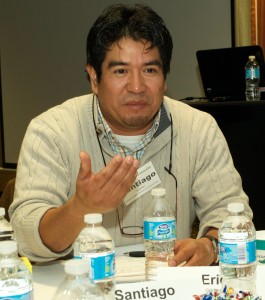
“It’s the different perspectives — all the time you see knowledge crossing from one person to another,” Grande said. “People have innovative ways of approaching things. We all learn from each other.”
The BootCamp began Nov. 19, at a reception where Axonify chief executive officer Carol Leaman urged charitable non-profits to embrace risk-taking — and the failure that might come with it — as a pathway to success.
On Friday (Nov. 20), governance experts Fred Galloway and Don McCreesh talked about how board governance and non-profit leadership need to adapt to climate change of a different sort. Funders, governments and media these days have ever greater expectations about accountability and transparency.
Well-governed organizations also have the muscle to take risks.
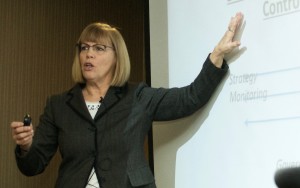
To get there, the experts said, organizations should fill vacant board positions through a careful recruitment process that zeroes in on skills and commitment. The days when board work meant casting a few votes and going home are long past.
Led by Ruth Cruikshank, an associate professor at the Lazaridis School of Business and Economic (Wilfrid Laurier University), Saturday’s session examined two case studies in the charitable non-profit sector: the reshaping of the Kitchener-Waterloo and Cambridge YMCAs into one administrative unit; and the evolution of the Grand River Jazz Society.
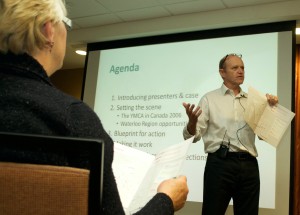
There was no “burning platform” nine years ago when the two YMCAs began exploring what they could do together, said John Hancock, chief executive officer (CEO) of the YMCAs of Cambridge and Kitchener-Waterloo. Both organizations were in good financial shape.
But there was an opportunity to look at doing things differently: the Cambridge Y was without at CEO at the time, and YMCA Canada wanted its local affiliates to seek out efficiencies.
Hancock, who was CEO in Kitchener, added Cambridge to his responsibilities on an interim basis while the two organizations took a year to study governance options. Amalgamation wasn’t on the table from the start.
Things were tense. A reasoned, give-it-a-try appeal from a major donor in Cambridge soothed some long-time Y members who viewed the change as a take-over from Kitchener. One of the things the process underscored, said Hancock, is the importance of communication during a difficult transition.
The organizations opted for a collaborative model of governance — separate boards that meet together and set the mission for a single administration. The organizations brought in outside help to sort out staffing.
At the start of the process, the Cambridge Y served 18,000 participants; the Y in Kitchener-Waterloo, 40,000. The organization now serves 78,000 from 56 sites.
“I believe we got a good outcome,” Gary Pooley, a former board member of the Kitchener-Waterloo Y, told the BootCamp. “This was about innovation. We created a new operating model and a new governance model.”
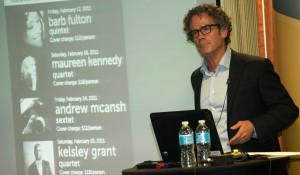
The Grand River Jazz Society started from scratch in 2011 — no boards, no assets and no loyalties to one community or another. The society and its showcase in Waterloo, The Jazz Room, took shape thanks to a lot of “entrepreneurial bricolage,” said founder Stephen Preece.
Bricolage is the term for art created from items that are scavenged, borrowed or used in ways outside their intended purpose. For the Jazz Room, this included developing a friendly agreement for space in the Huether Hotel, scoring a deal on a refurbished grand piano and earning the financial goodwill of a backer.
Today, the Jazz Room draws about 6,500 people a year. The society recently received its charitable status.
Top international musicians perform in the Jazz Room. But providing a stage for local talent lies at the heart of the Society’s artistic mission, said Preece, who is also an associate professor in business at Laurier.
The society’s story is a startup story, he said, with lots of lessons about chasing leads, scrounging and adapting.
“How does this relate to the non-profit sector?” Preece said at the start of his presentation. “Just use ‘innovation’ every time you hear the word ‘startup.’ ”
